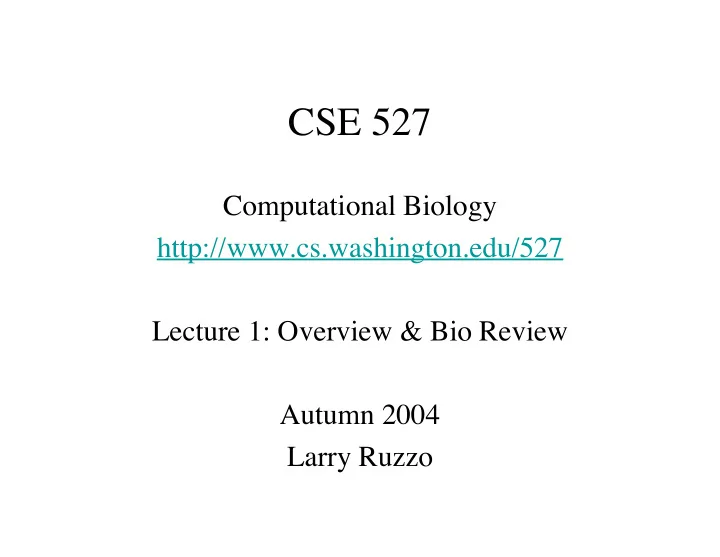

CSE 527 Computational Biology http://www.cs.washington.edu/527 Lecture 1: Overview & Bio Review Autumn 2004 Larry Ruzzo
He who asks is a fool for five minutes, but he who does not ask remains a fool forever. -- Chinese Proverb
Related Courses • Genome 540/541 (Winter/Spring) – Intro. To Comp. Mol. Bio. • Stat/Biostat 578 (A 2004) – Statistical Analysis of Microarrays • CSE590CB (AWS) – Reading & Research in Comp. Bio. – Monday’s, 3:30 (MEB 243 this quarter) – http://www.cs.washington.edu/590cb • Combi Seminar (Genome 521; AWS) – Wednesday’s 1:30 K069 (sometimes 3:30 Hitch 132)
Homework #1 • Find & read a good primer on “bio for cs” (or vice versa, as appropriate) e.g., see ones listed on 590cb page • Email me a few sentences saying – What you read (give me a link or citation) – Critique it for your meeting your needs – Who would it have been good for, if not you
Source: http://www.intel.com/research/silicon/mooreslaw.htm
Growth of GenBank (Nucleotides) 100,000,000,000 1,000,000,000 10,000,000 100,000 1980 1985 1990 1995 2000 2005 Source: http://www.ncbi.nlm.nih.gov/Genbank/genbankstats.html
What’s all the fuss? • The human genome is “finished”… • Even if it were, that’s only the beginning • Explosive growth in biological data is revolutionizing biology & medicine “All pre-genomic lab techniques are obsolete” (and computation and mathematics are crucial to post-genomic analysis)
A VERY Quick Intro To Molecular Biology
The Genome • The hereditary info present in every cell • DNA molecule -- a long sequence of nucleotides (A, C, T, G) • Human genome -- about 3 x 10 9 nucleotides • The genome project -- extract & interpret genomic information, apply to genetics of disease, better understand evolution, …
The Double Helix Los Alamos Science
DNA • Discovered 1869 • Role as carrier of genetic information - much later • The Double Helix - Watson & Crick 1953 • Complementarity – A ←→ T C ←→ G
Genetics - the study of heredity • A gene -- classically, an abstract heritable attribute existing in variant forms ( alleles ) • Genotype vs phenotype • Mendel – Each individual two copies of each gene – Each parent contributes one (randomly) – Independent assortment
Cells • Chemicals inside a sac - a fatty layer called the plasma membrane • Prokaryotes (e.g., bacteria) - little recognizable substructure • Eukaryotes (all multicellular organisms, and many single celled ones, like yeast) - genetic material in nucleus, other organelles for other specialized functions
Chromosomes • 1 pair of DNA molecules (+ protein wrapper) • Most prokaryotes have just 1 chromosome • Eukaryotes - all cells have same number of chromosomes, e.g. fruit flies 8, humans & bats 46, rhinoceros 84, …
Mitosis/Meiosis • Most “higher” eukaryotes are diploid - have homologous pairs of chromosomes, one maternal, other paternal (exception: sex chromosomes) • Mitosis - cell division, duplicate each chromosome, 1 copy to each daughter cell • Meiosis - 2 divisions form 4 haploid gametes (egg/sperm) – Recombination/crossover -- exchange maternal/paternal segments
Proteins • Chain of amino acids, of 20 kinds • Proteins are the major functional elements in cells – Structural – Enzymes (catalyze chemical reactions) – Receptors (for hormones, other signaling molecules, odorants,…) – Transcription factors – … • 3-D Structure is crucial: the protein folding problem
The “Central Dogma” • Genes encode proteins • DNA transcribed into messenger RNA • RNA translated into proteins • Triplet code (codons)
The Genetic Code
Translation: mRNA → Protein Watson, Gilman, Witkowski, & Zoller, 1992
Ribosomes Watson, Gilman, Witkowski, & Zoller, 1992
Gene Structure • Transcribed 5’ to 3’ • Promoter region and transcription factor binding sites precede 5’ • Transcribed region includes 5’ and 3’ untranslated regions • In eukaryotes, most genes also include introns, spliced out before export from nucleus, hence before translation
Genome Sizes Base Pairs Genes Mycoplasma genitalium 580,073 483 E. coli 4,639,221 4,290 Saccharomyces cerevisiae 12,495,682 5,726 Caenorhabditis elegans 95.5 x 10 6 19,820 Arabidopsis thaliana 115,409,949 25,498 Drosophila melanogaster 122,653,977 13,472 Humans 3.3 x 10 9 ~25,000
Genome Surprises • Humans have < 1/3 as many genes as expected • But perhaps more proteins than expected, due to alternative splicing • There are unexpectedly many non-coding RNAs • Many other non-coding regions are highly conserved, e.g., across all mammals
… and much more … • Read one of the many intro surveys or books for much more info.
Recommend
More recommend